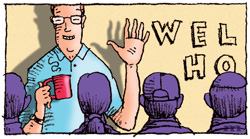Educational seminars offer custom builders an opportunity to meet prospects in a low-risk environment. Prospects get to know you—and you get to know them. Attendees are likely to comment about your program to friends and colleagues, generating more marketing possibilities. Long term, you can establish a reputation as the area’s expert on custom building. The investment, once your program is developed, is modest compared to the potential reward.
Home-buying seminars work best when you schedule them outside normal business hours; Saturday mornings are popular, with Thursday evenings a good second choice. Alternating may be an effective combination. Two hours seems to be a good time frame: 90 minutes for the presentations and 30 minutes for Q&A.
Planning the Presentation. Organizing the content takes careful thought and planning. You want to convey enough information to impress prospects and still leave them wanting to learn more. For a polished presentation—and one that stays with the planned program and holds audience attention—an LCD projector and slide presentation is ideal.
Some builders have a projector for training purposes. If you do not already have one, you can rent one for $250 to $400 a day. Once you decide that these presentations will be a permanent part of your marketing plan, you’ll want to purchase one. Reasonably good LCD projectors start at $1,500.
Decide what subjects to cover and how much detail to include. Make no attempt to cover every last detail. Select topics that are critical, and support them with key points. Avoid doing a sales pitch but do demonstrate your knowledge, experience, and professionalism. Chronological organization works well. Highlight the steps in your custom process, including mention of typical time frames for each. Each slide should cover just one idea or topic, with supporting details. The progression from subject to subject should be logical and clear. Describe your design process before you address change orders. Talk about scheduling and then address how delivery-date targets are set and how often you revise this information.
Once you have the main content organized, plan an introduction. Open with a welcome followed by a brief overview of the agenda. Cover housekeeping details as necessary. Mention that you will take questions at the end, and that you will also be available to discuss unique situations immediately following the meeting or in a follow-up appointment. If a question comes up that you don’t know the answer to, commit to getting the answer and forwarding it to all participants as part of your follow up. “That’s a good question. I will find out and let all of you know.” This actually creates one more way for you to stay in touch with the attendees. At the end, ask attendees for feedback. In particular, you want to learn whether your information was helpful and sufficiently detailed without being too technical.
Advance Prep. Here are a few things to think about in order to get ready for a home-buying seminar:
Slide Presentations. The best known slide presentation software packages are probably Microsoft’s Power Point and Corel’s Presentation. These and others typically include a variety of built-in background designs, formats, and pre-planned color combinations. You can also create your own.
Use 18 point or higher as your smallest font size. Follow the 6×6 rule (six bullets, six words each) or 5×7 rule (five bullets, seven words each) for most of your slides. A digital camera can bring an entirely different dimension to your presentations with photos of your current and past projects. Add your company logo on the “Welcome” and “Thank You” slides.
Rehearse, Rehearse, Rehearse. The cure for stage fright is thorough preparation and a belief that the information you are presenting is valuable to your audience. Practice alone, focusing on smooth transitions from one key point to the next. Next, hold a dress rehearsal with employees or some of your trades as the audience. Their feedback will help you anticipate questions that actual home buyer audiences might ask.
Location. Before you can invite anyone, you’ll need to decide on a meeting location. If your office has an appropriate space, this issue is solved. Otherwise, balance image, cost, and convenience. Hotels, libraries, and the local board of Realtor office offer possibilities. Space should be appropriate to the size of your group; a tiny gathering in a large room full of empty seats is awkward.
Gather an Audience. To attract an audience, begin with an announcement on your Web site and provide your salesperson with invitations. Use community newspapers, real estate offices, current and past customers, and trade contractors to spread the word. Send out a press release.
On with the Show. Because we are accustomed to reading from left to right, stand to left of the screen from the audience’s perspective. Walking around is OK as long as it is varied—avoid a shooting-gallery style of pacing. Also avoid staring at the screen or reading all of the bulleted points on each slide—an occasional glance at your laptop screen should be sufficient to prompt your next remark. The audience can read the bullets; your remarks should add further to the information.
Maintain good eye contact, including the folks in the back row and at the sides. Remember to advance the computer to the next slide as you change topics—a common challenge for inexperienced (or nervous) speakers. Avoid apologizing, such as “I’m not a natural born speaker so I’m a little nervous tonight.”
After the seminar, review audience feedback and promptly forward answers to follow-up questions to all attendees. Follow through on individual appointments as needed. Send thank you notes to everyone and then stay in touch with good prospects.
Persistence will pay off in this effort. It would be unrealistic to think every attendee will do business with you in the future, but many will. And when they do, they will already understand a lot about your processes.
Carol Smith offers customer service assessment, consulting, and training programs for home builders. She can be reached at csmithhomeaddress@att.net.



